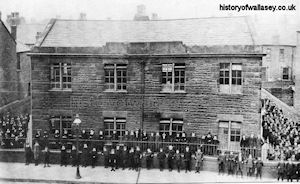The Beginnings of Formal Schooling in Our Area
By Alan G. Jones
“We are obliged to close the door of the school against many boys whose parents are desirous that they should attend. We cannot admit them for want of room”. So wrote the Rev. John Tobin of St. John’s church in 1851. He was writing about St. John’s National school in Liscard. The building was erected in 1839.
The numbers attending the school in 1851 were 122 boys, 96 girls and 104 infants. It was found that the boys school was full but the numbers included about thirty-five boys from Wallasey Village. There was a hope by the authorities that there would be a school for boys there soon enough. A girl and infant‘s school was founded in connection with St. Hilary’s Parish Church in 1840 and eventually a boy’s school was built.
The beginning of a national system of education in England and Wales came in the early years of the nineteenth century. The most effective of the schools for the poor were run by two religious societies, the National Societies (for Anglicans) founded in 1811 and the British and Foreign Society (for non-Conformists) founded in 1814.
Although the Church societies provided many schools (the National Society alone founded 3,000 in twenty years) they only catered for a small fraction of England’s children.
In Wallasey, the residential nature of the population led to the establishment of many private schools, so that when Wallasey possessed only two national schools there were already ten private academies. By 1861, there were five national schools attached to a Church of England. In 1860, the National School in Liscard was described as ‘a neat edifice affording accommodation to about 200 children...’ The master was Mossop Curwen, from Cumberland and stayed at St. John’s for a number of years. He died in 1900.
Financial assistance was received from the National Society under whose patronage, Church schools were run. The Log-book (1866-94) of the infant school which is amongst the Church records almost exactly covers the period of ‘Payment by Results’. This meant that the money secured by a school depended upon the success of its pupils in an annual examination in the three R’s (reading, ‘riting, ‘rithmetic), plus a satisfactory level of average attendance. The reports of St. John’s were normally satisfactory but on two occasions there were warnings that if the teaching did not improve, the grant would be withheld.
In 1885, an extract from the log-book of St. John’s states ‘The premises are, as usual, most discreditable to a comparatively wealthy district’. In July 1894, the school was transferred to the church of St. Mary, Liscard. By the turn of the century, St. Mary’s had an enviable reputation in the sporting field. Perhaps its proximity to Central Park had something to do with the fact that its team excelled at cricket and football.
The school administrators set great store by reading, writing and arithmetic. Pupils were extremely diligent and discipline was strict. The pupils at the school in the early 1900’s belonged to a Wallasey that was still a collection of villages, Seacombe, Liscard, Poulton and so on, which were linked by noisy tramcars. The streets were gas-lit, some of the ferry boats were still paddle-driven and beer was a penny a pint in the 60 local ‘Locals’.
In July 1928, thirty four years to the month after its transfer from St. John’s, St. Mary’s closed and the children of the area moved to the new school at Egerton Grove. The last headmaster at St. Mary’s was Ernest Webster. He remained living in the Liscard area until he died in 1969. In November 1928, at the Law Association room in Liverpool, St. Mary’s Boy’s School, Liscard Road was sold by auction for a sum of £1,830. So ended many years of use for the building as a school, but even today, the building still stands opposite the Ambulance Station in Liscard Road and is being used as a Wirral Metropolitan College.
Featured sites
- Non Gamstop Casinos
- Casino Not On Gamstop
- UK Casinos Not On Gamstop
- Non Gamstop Casinos UK
- Sites Not On Gamstop
- Sites Not On Gamstop
- Casinos Not On Gamstop
- Casinos Not On Gamstop
- Casinos Not On Gamstop
- Non Gamstop Casino UK
- Casinos Not On Gamstop
- Non Gamstop Casino
- UK Online Casinos Not On Gamstop
- UK Online Casinos Not On Gamstop
- Non Gamstop Casinos
- Casino Sites Not On Gamstop
- Casinos Not On Gamstop
- Casinos Not On Gamstop
- Best Betting Sites
- Casinos Not On Gamstop
- Gambling Sites Not On Gamstop
- Betting Sites That Are Not On Gamstop
- Non Gamstop Casinos UK
- UK Online Casinos Not On Gamstop
